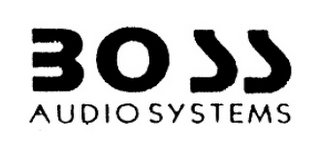TTAB Finds "BOSS AUDIO" and "AUDIO BSS" Logos Confusingly Similar in a Citable Decision
In its second citable decision of 2006, the Board sustained a Section 2(d) opposition to registration of the mark AUDIO BSS USA & design (shown immediately below) for car amplifiers, speakers, and stereos (AUDIO and USA disclaimed), finding it likely to cause confusion with the mark BOSS AUDIO SYSTEMS & design (shown further below), registered for automobile audio components, including amplifiers and speakers (AUDIO SYSTEMS disclaimed). Opposer's survey evidence corroborated the Board's du Pont analysis. Ava Enterprises, Inc. v. Audio Boss USA, Inc., 77 USPQ2d 1783 (TTAB 2006).
 The Board observed that because the involved goods are identical in part, "the degree of similarity required to support a conclusion of likely confusion declines." It noted that the goods would be sold in the same channels of trade to the same consumers, who would "not necessarily be expected to exercise a high degree of care in purchasing these products."
The Board observed that because the involved goods are identical in part, "the degree of similarity required to support a conclusion of likely confusion declines." It noted that the goods would be sold in the same channels of trade to the same consumers, who would "not necessarily be expected to exercise a high degree of care in purchasing these products." The Board ruled that BOSS is the dominant portion of the registered mark and that, in light of Applicant's disclaimers, the letters BSS constitute the dominant portion of Applicant's mark. It recognized that there are some differences in the marks because BOSS and BSS do not sound alike, and because the connotations are dissimilar: the registered mark suggests products that are "top-of-the-line," whereas Applicant's mark has no meaning.
The Board ruled that BOSS is the dominant portion of the registered mark and that, in light of Applicant's disclaimers, the letters BSS constitute the dominant portion of Applicant's mark. It recognized that there are some differences in the marks because BOSS and BSS do not sound alike, and because the connotations are dissimilar: the registered mark suggests products that are "top-of-the-line," whereas Applicant's mark has no meaning.However, the Board found the marks "highly similar" in appearance and commercial impression: both marks include the word AUDIO, the dominant portions differ by only a single letter, and the marks are in "virtually the same distinctive font." The Board also noted (in a good example of litotes) that the circular design in Applicant's mark "is not unlike the letter 'O'."
"In order for a likelihood of confusion to exist, two marks need not be similar in sound, appearance, connotation and commercial impression. Rather, similarity in either [sic] respect alone may be sufficient to support a finding of likelihood of confusion."
Finally, based on Opposer's annual sales of $50 million and annual advertising expenditures of $1 million, the Board found the registered mark to be a strong mark in its field (albeit not famous).

The Board then reviewed Opposer's survey results: 57% of respondents exposed to the marks "thought they come from the same company or that the companies that make the brands are connected or associated."
Finally, the Board stopped short of finding a bad faith intent on the part of Applicant, but it noted that "applicant's adoption of a mark which includes a unique font essentially identical to that used by opposer certainly raises an eyebrow."
Considering the relevant du Pont factors, "including the identity of the goods, the trade channels and purchasers, the lack of sophistication of the purchasers, and the marks' similarity in appearance and commercial impressions," the Board concluded that confusion is likely. The survey results "corroborate that conclusion."
Text Copyright John L. Welch 2006.




0 Comments:
Post a Comment
<< Home